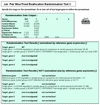Relative expression software tool (REST) for group-wise comparison and statistical analysis of relative expression results in real-time PCR
- PMID: 11972351
- PMCID: PMC113859
- DOI: 10.1093/nar/30.9.e36
Relative expression software tool (REST) for group-wise comparison and statistical analysis of relative expression results in real-time PCR
Abstract
Real-time reverse transcription followed by polymerase chain reaction (RT-PCR) is the most suitable method for the detection and quantification of mRNA. It offers high sensitivity, good reproducibility and a wide quantification range. Today, relative expression is increasingly used, where the expression of a target gene is standardised by a non-regulated reference gene. Several mathematical algorithms have been developed to compute an expression ratio, based on real-time PCR efficiency and the crossing point deviation of an unknown sample versus a control. But all published equations and available models for the calculation of relative expression ratio allow only for the determination of a single transcription difference between one control and one sample. Therefore a new software tool was established, named REST (relative expression software tool), which compares two groups, with up to 16 data points in a sample and 16 in a control group, for reference and up to four target genes. The mathematical model used is based on the PCR efficiencies and the mean crossing point deviation between the sample and control group. Subsequently, the expression ratio results of the four investigated transcripts are tested for significance by a randomisation test. Herein, development and application of REST is explained and the usefulness of relative expression in real-time PCR using REST is discussed. The latest software version of REST and examples for the correct use can be downloaded at http://www.wzw.tum.de/gene-quantification/.
Figures
References
-
- Bustin S.A. (2000) Absolute quantification of mRNA using real-time reverse transcription polymerase chain reaction assays. J. Mol. Endocrinol., 25, 169–193. - PubMed
-
- Pfaffl M.W. and Hageleit,M. (2001) Validities of mRNA quantification using recombinant RNA and recombinant DNA external calibration curves in real-time RT–PCR. Biotechnol. Lett., 23, 275–282.
-
- Lockey C., Otto,E. and Long,Z. (1998) Real-time fluorescence detection of a single DNA molecule. Biotechniques, 24, 744–746. - PubMed
-
- Steuerwald N., Cohen,J., Herrera,R.J. and Brenner,C.A. (1999) Analysis of gene expression in single oocytes and embryos by real-time rapid cycle fluorescence monitored RT–PCR. Mol. Hum. Reprod., 5, 1034–1039. - PubMed
-
- Wittwer C.T., Ririe,K.M., Andrew,R.V., David,D.A., Gundry,R.A. and Balis,U.J. (1997) The LightCycler: a microvolume multisample fluorimeter with rapid temperature control. Biotechniques, 22, 176–181. - PubMed
Publication types
MeSH terms
Substances
LinkOut - more resources
Full Text Sources
Other Literature Sources





